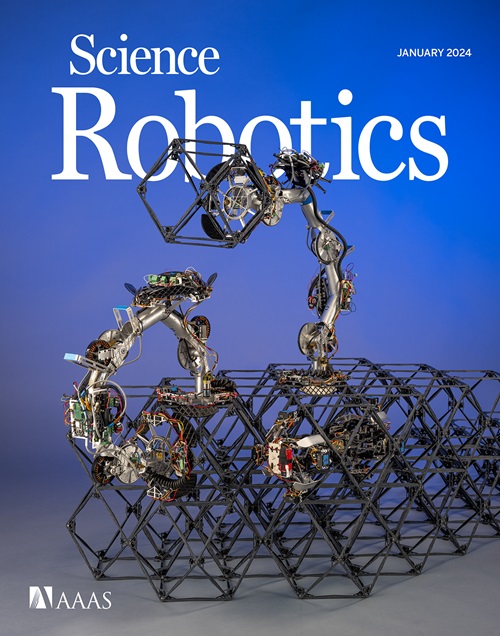Learning agile soccer skills for a bipedal robot with deep reinforcement learning
IF 26.1
1区 计算机科学
Q1 ROBOTICS
引用次数: 0
Abstract
We investigated whether deep reinforcement learning (deep RL) is able to synthesize sophisticated and safe movement skills for a low-cost, miniature humanoid robot that can be composed into complex behavioral strategies. We used deep RL to train a humanoid robot to play a simplified one-versus-one soccer game. The resulting agent exhibits robust and dynamic movement skills, such as rapid fall recovery, walking, turning, and kicking, and it transitions between them in a smooth and efficient manner. It also learned to anticipate ball movements and block opponent shots. The agent’s tactical behavior adapts to specific game contexts in a way that would be impractical to manually design. Our agent was trained in simulation and transferred to real robots zero-shot. A combination of sufficiently high-frequency control, targeted dynamics randomization, and perturbations during training enabled good-quality transfer. In experiments, the agent walked 181% faster, turned 302% faster, took 63% less time to get up, and kicked a ball 34% faster than a scripted baseline.利用深度强化学习为双足机器人学习敏捷足球技能
我们研究了深度强化学习(deep RL)是否能够为低成本的微型仿人机器人合成复杂而安全的运动技能,并将其组成复杂的行为策略。我们使用深度强化学习训练仿人机器人进行简化的一对一足球比赛。训练后的机器人表现出了强大的动态运动技能,如快速倒地恢复、行走、转身和踢球,并能以流畅高效的方式在这些技能之间进行转换。它还学会了预测球的移动和阻挡对手射门。该代理的战术行为能适应特定的比赛环境,而人工设计是不切实际的。我们的代理是在模拟中训练出来的,并在真实机器人上实现了零投篮。足够高频率的控制、有针对性的动态随机化和训练期间的扰动相结合,实现了高质量的转移。在实验中,与脚本基线相比,代理行走速度提高了 181%,转身速度提高了 302%,起身时间缩短了 63%,踢球速度提高了 34%。
本文章由计算机程序翻译,如有差异,请以英文原文为准。
求助全文
约1分钟内获得全文
求助全文
来源期刊

Science Robotics
Mathematics-Control and Optimization
CiteScore
30.60
自引率
2.80%
发文量
83
期刊介绍:
Science Robotics publishes original, peer-reviewed, science- or engineering-based research articles that advance the field of robotics. The journal also features editor-commissioned Reviews. An international team of academic editors holds Science Robotics articles to the same high-quality standard that is the hallmark of the Science family of journals.
Sub-topics include: actuators, advanced materials, artificial Intelligence, autonomous vehicles, bio-inspired design, exoskeletons, fabrication, field robotics, human-robot interaction, humanoids, industrial robotics, kinematics, machine learning, material science, medical technology, motion planning and control, micro- and nano-robotics, multi-robot control, sensors, service robotics, social and ethical issues, soft robotics, and space, planetary and undersea exploration.
 求助内容:
求助内容: 应助结果提醒方式:
应助结果提醒方式:


